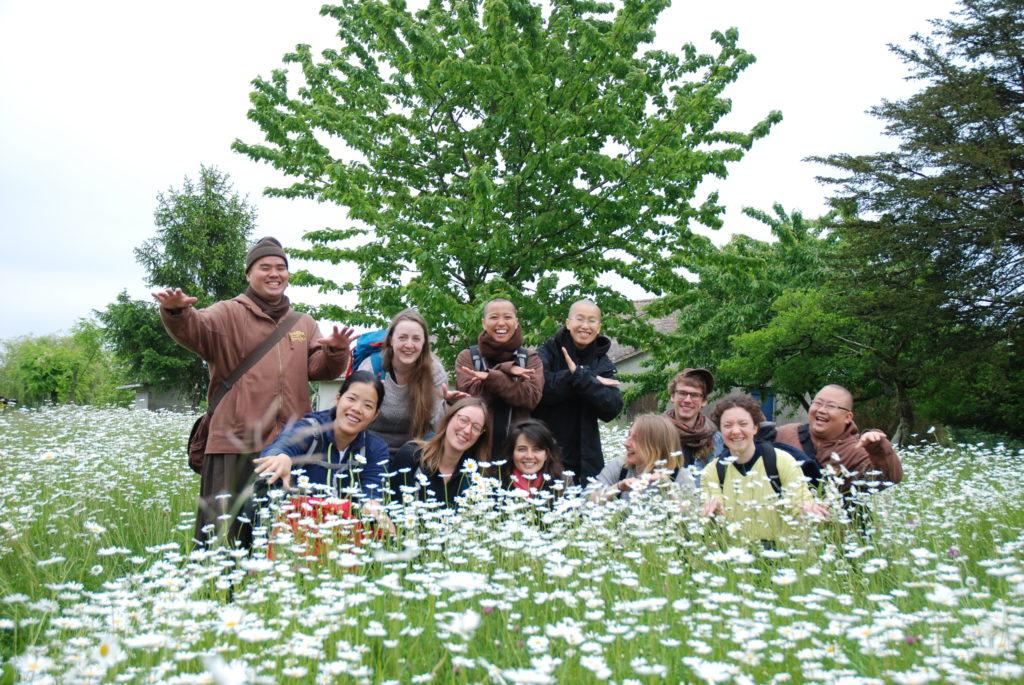When We Have No Choice
Sometimes, says Pema Khandro, there’s no way out. It’s at those times that we can discover the depth and resilience of the mind. The post When We Have No Choice appeared first on Lion's Roar.

Sometimes, says Pema Khandro, there’s no way out. It’s at those times that we can discover the depth and resilience of the mind.

“Red Sea,” 2016. Painting by Mary Devincentis.
There are times when we have to make a choice, either to change a situation—put up a boundary, build walls, create an exit, whatever it might take to no longer be in that hardship—or to endure it. Those times, when our agency is still so available and when we can change our circumstances, are for another day’s writing. This is about the other times, the times when we must endure the hardships, when we don’t have the choice or opportunity or freedom to change how things are. This is for when the only thing to do is work with our own minds. This is for when we cannot get out.
We should know that it happens like this in a life; things get hard, and then they get harder, and there is no end in sight. Sometimes an end comes only to reveal more obstacles, and there is no relief. It is like that sometimes. During the pandemic, there have been so many circumstances in which endurance is the only option: single mothers who have to care for their children and somehow also find time for work; those caring for sick, dying, or mentally ill family members; those in a lockdown, and there is no place to go. There are times when endurance, and how we endure, matters, when the main question is how mind can make it through without getting lost in darkness. You may already know that this is how it can be. If so, you are not alone.
At such times, it is worthwhile to reflect on the life of Yeshe Tsogyal, the female bodhisattva of Tibet. Her autobiography suggests that within hardship, one can find endurance by transforming one’s mind. Tsogyal was a ninth-century figure; her autobiography, told to her consort, was revealed in the seventeenth century, when it was discovered as a treasure text. So her story emerged in a time of incredible hardship, of international power struggles and violence. It was a story that needed to be told and was heard at a moment in history when hardships were abundant and safety and ease were far away. It offers guidance for excruciating times.
Even when we don’t have the agency to change circumstances, there is still some freedom and rest to be had in mind, some way to find our tenacity. This is not about a tenacity and courage that is contrived, but one that comes from our bones, from our gut, from the innermost recesses of the space of mind. During times like these, I often remember the stories of the lineage. These stories offer encouragement and engage us in the complex task of interpreting Buddhism through a life. And when I think of endurance, the story I turn to is of Tsogyal receiving advice from her teacher.
Tsogyal was a princess, but she did not have an easy life. She was mugged and assaulted numerous times. She was poisoned by jealous people. But in meeting her teacher, Padmasambhava, the tantric buddha of Tibet, she gained a sublime opportunity to train in buddhadharma.
In our greatest hardship, to also think of other people’s sorrow seems like too much. But by the power of our interdependence with beings, by acknowledging this interconnection through open-hearted presence, we actually find relief.
When it was time for her to go into intensive training, Tsogyal went into a cycle of practices called the eight austerities. To accomplish them, she went on retreat on a glacier high in the Himalayas. She went to a place of extreme isolation where even if she called for help, no one would hear her cry. At first, she went with a companion. But after a year, this companion felt the glacier was too cold and too difficult, and left, leaving Tsogyal up there practicing by herself, doing austerities and yogic feats to test and train the mind. At one point, there were blisters all over her body. At another, she couldn’t even stand on her legs. There was one phase when she could no longer even hold her head up in meditation. The point of the austerities was to train the mind through extreme circumstances; the instruction was to maintain the practices no matter what arose, no matter the obstacles. And she did—through all these physical hardships, she maintained her meditation.
In the third year, though, Tsogyal started to lose heart, and with it her skill in the practice. Doubts filled her mind. She persevered, but her stamina wore out and she became increasingly weak and ill until it was clear that she might die—and there was no one around to hear her cries for help. In this case, her hardship was a situation she had initially chosen, but which then became a situation far beyond her capacity. Her only options were to die or to sustain the hardship and somehow make it through. It was at that crossroads that she prayed to Padmasambhava, crying out for him to come and help her. Somehow, by dream or mystic vision or supernatural power, her teacher appeared in front of her and gave her advice—advice that guided her not only through that moment, but also through a lifetime of practice, all the way to her enlightenment.
“Take joy and sorrows as the path”
Padmasambhava appeared to Tsogyal and said, “Ever wont to be intolerant of unpleasant situations, now is the time to take joy and sorrows as the path, whatever hardships now befall you.”
This phrase, “to take joy and sorrows as the path,” appears in numerous, maybe hundreds of Tibetan prayers. It refers to the ability to take an experience and make use of it to train, to see into the nature of reality, to clarify what we are. It also refers to the power available in extreme hardship, the way that petty concerns are naturally silenced. Things get very real, very direct.
Like when we lose a loved one—in the face of that mountain of grief, all the little squabbles, the little stresses that we carry around from day to day, they just fall away. In that hardship there is a silence, and with it a liminality. This is the space needed for a certain kind of work to be done in mind.
There is a prayer, “Carrying Joy and Sorrow onto the Path,” that I always share when I teach the life of Tsogyal. It teaches us how to suffer. It reads, “If suffering comes, use the opportunity to take on the burden of everyone’s suffering. May an ocean of suffering be emptied.” This is a practice of radical empathy, a Buddhist method for dealing with suffering by opening to feeling the suffering of others. In our greatest suffering, we consider people who are also in a situation just like ours. We contemplate the other mothers and daughters, sons and fathers, brothers and friends, the people who are also facing this same pain. We connect into their suffering as well as our own. This, of course, is a practice for discovering the altruistic enlightened intent where, with our broken open heart, we easily find the wish that the suffering of all will be cleared away. This is how we suffer—together, with others. We dedicate our suffering so that it might clear suffering for all.
This is counterintuitive—in our greatest hardship, to also think of other people’s sorrow seems like too much. It is already too much. But there is something that happens by the power of our interdependence with beings, something at the core of what we are. By acknowledging this interconnection through open-hearted presence, we actually find relief.
The prayer continues, “If sickness comes, take this opportunity to exhaust the lifetimes of karma. May the sickness of all beings be completely cleared away.” We pray in the midst of our own illness to also remember the illness of others. And it goes even further than that: it is a prayer to realize that we not only have the sickness of this moment to burn with, but also the impending illness of lifetimes of karma.
How do we find our way here, to where we are? One doorway to acceptance is to dedicate the experience.
Buddhists take varying views on karma. One misinterpretation is that karma is somehow a fate, that we can’t help ourselves, like a bill that is coming due in the future and all we can do is wait. But Buddhist philosophy actually presents a very different theory of karma—that precisely because of cause and effect, we can take positive actions. We can change our future. We can change our situation. In that sense, teachings on karma emphasize the power of our actions to shape our lives. There is agency rather than fate.
Karma can also be treated another way: as a lens to find acceptance. Without such acceptance, there can be no capacity for endurance. When it is time to endure, it is crucial to let go of the resistance, to see this as it is and just ride through it. Sometimes that is the only thing we can do. In those moments, the prayer offers a way to accumulate positive momentum and merit. It shows a way to free the mind, the opportunity to reframe the situation as a way to pay off negative karma. It is truly terrible, but terribly true, that we must sometimes accept the situation and be right there with it.
How do we find our way here, to where we are? One doorway to acceptance is to dedicate the experience. When we cannot change it, at the very least we can use it to clear negativity from our past by regarding this as another scene in the unfolding of our own karma, as an opportunity to clear it or, at the very least, to train. This is the courage and resilience of meeting things just exactly as they are.
“Be less desirous of an easy life”
This advice from Padmasambhava to Tsogyal, “Be less desirous of an easy life,” is poignant and difficult. It is a stunning thing to say to someone who has not had an easy life, who was in incredible pain and about to die. But in difficult circumstances, I remember this prayer and it relaxes me every time. I am reminded that sometimes it is not easy; this is our practice, this is our training, this is our teacher. I let go of any idea that it should be some other way.
From the point of view of Buddhist teachings, a less easy life is, karmically speaking, sometimes necessary and efficacious.
Such was the case for Milarepa, Tibet’s most famous yogi. He, his mother, and his sister were abused and enslaved by Milarepa’s uncle and aunt when he was a child. Milarepa later took revenge, murdering thirty-five people. When he regretted what he had done and turned to the buddhadharma to break free from karma, he underwent extremely difficult training, full of physical hardships and devoid of any emotional support or assurance. The legend of Milarepa explicitly describes these difficulties as necessary to purify the karma of the murders, like polishing a stained object. But besides purification of karma, perhaps this was the only way to know for sure that Milarepa would not murder again—to see he had faced similar hardships and maintained a pure intention regardless. This is one useful thing about our horrible circumstances: that by enduring them, we will know. We will know that we can maintain integrity while challenged. We will know that we can work with mind as our fundamental condition. This is the way we will find true and deep compassion. We will know.
“Meditate on impermanence”
Padmasambhava’s third piece of advice was simply “Meditate on impermanence.” In the outer preliminaries, there is the practice of meditating on every possible example of impermanence there is. This is the formal first part of the study of Buddhist tantra in Tibet. I used to get so bored, going through this again and again. The seasons are impermanent. Fall changes into winter. Winter changes into spring. Spring changes into summer. Morning changes into noon. Noon changes into afternoon. Afternoon changes into evening. And on and on and on, every possible example. Kings one day die and fall from their throne. Beggars also die. Everyone dies. Everything you can think of—every single thing—is impermanent and passing away.
A couple of years ago, I was teaching a similar text. We had studied together month after month for a year; just as we finished the section on impermanence, the pandemic hit, and the world as we had known it ceased. By the time we met again online, we were all in lockdown, and the truth of impermanence was inescapable. The point of these practices is that we need to contemplate this, so we can be ready to accept it and work with life as it is. So we can be prepared. So we can endure.
There is another way that impermanence can be taught: as a liberating factor, as a knowledge that whatever arises, whatever one experiences, it has its peak and then it dissipates. Every experience will arise and then dissolve. To contemplate impermanence like this in the midst of hardship can bring relief. This is here, this is this moment. But everything from the seasons to the cycles of the day, even for kings and rulers, rich or poor—everything changes. We only have to be here right now. Knowing this, we can bear anything.
“Reveal your hidden faults”
The fourth instruction that Padmasambhava gave to Tsogyal rests on the third, because it is from impermanence that we find the bravery to withstand seeing our own mind.
Mind is so intense. To see the dense private world of our own fantasies requires a direct experience of impermanence and emptiness; without that, we get lost in what we see. It is the lovely side of impermanence to be in the moment, present, one breath at a time—to let go, in this moment, of the one that came before.
The fourth instruction is “Reveal your hidden faults. Don’t hide your latent vices. Lay bare your inadequacies.” This is a psychological method to get past self-deception, which is so overwhelming, so compelling, so total. It is so thick with meaning, much of which we cannot see. Our own motives—we don’t always know them. Even our most intense experiences, our traumas, our heartbreaks—they are felt so deeply but touched by so much we don’t understand. How do we find the subconscious mind? What is it full of, and how can we empty it? When do the seeds lying dormant underneath the ground of what is known suddenly sprout and take over our lives?
There is already too much of mind that we do not see, that we do not know. What we can see, we can share and name.
To work with mind is to work in unchartered territory, perhaps the last uncharted territory on Earth. To work with mind is to see something surprising, treacherous, beautiful, ugly, frightening, innocent. This all has to be seen. It has to—when things fall apart, it is all there is, all our hidden faults and latent vices, laid bare. When facing hardships, our mental habits are there as the voice that responds to the most important questions: why am I in this situation? What does this mean about me? What matters in those moments is that we look past self-deception. This is the vigorous honesty that is required to see ourselves and develop spiritual maturity.
There was a lovely scene, later in Tsogyal’s life, in which she met the great yogini Mandarava. They exchanged teachings and praises, endlessly discussing the dharma, and as they did, they also acknowledged the attainments and hardships the other had been through: “You got free from the shackles of defiled emotions”; “You repudiated the eight petty concerns of this life.” It is a rare description of friendship, as well as a glimpse of the two great yoginis’ mutual vulnerability.
One way we can “reveal our hidden faults” is by telling the whole truth of our life—to ourselves, and to someone else. This is so important. This is how we are able to reveal our hidden faults, how we expose our latent vices, how we lay bare our inadequacies. It is how we get used to being what we are, how we relax into showing what we are, the whole thing—the whole story of our own samsara and nirvana. In hardship, this—our own sense of honesty with ourselves—may be the only comfort we have. All those confusions that fill the skies of mind—we must see them, name them, and then be seen ourselves. There is already too much of mind that we do not see, that we do not know. What we can see, we can share and name.
“Expose your secret self and take courage”
In Padmasambhava’s fifth instruction to Tsogyal, he told her, “Sanctimonious nun, ever wont to be over-extended in deceit, now is the time to throw off hypocrisy and dissimulation. Expose your secret self and take courage.”
In this advice, Padmasambhava is naming one of Tsogyal’s obstacles: the arrogance and pretense that came with her station in life. In this instruction, she was being taught to stretch beyond all artifice. That is usually so hard, but less so when we are under extreme duress. We are so exposed, so vulnerable, so fragile, that there is very little capacity to pretend.
Years ago, I contracted Rocky Mountain spotted fever, and for a while it seemed I might not live. I entered that raw place that illness can put us in, similar to pure meditation, where we can no longer be the person we usually pretend to be. That fictive self that we try to be, that good version—I couldn’t perform a self anymore. Instead, through the debilitation of my whole body, there was the natural space of being exactly as I was. During that same time, some family drama unfolded around me, and I could do nothing. There was no way to negate it or lessen it; I was so weak and in so much pain. From that place, I could notice for myself that yes, the situation was difficult, but I could also see the impulse arising from my mind to fix things, and that the stress of that came from within. The only thing to do was to see that inside myself and let it go. As it promises in the Bhavanakrama (“Stages of Meditation”), the more we let that thought go, the less those afflictions will arise in the future, and the less power they will have.
Before that experience, I had trained so much, in so many practices and under so many conditions, in so many countries—ordinary practices, extraordinary practices, and secret practices, for decades. But the practice I needed the most on my deathbed was the most basic teaching: to see a thought and let it go. Just that simple practice relieved me greatly. It is something lovely and painful about hardship, how it shows us our mind and tests us on the fundamental teachings. Secretly, perhaps we are all beginners. That’s a relief—we can find our courage in the simplicity of our beginner’s mind, our secret self that is always ever practicing for the first time again, always ever relating to the same basic principle.
On the night of Tsogyal’s awakening—many years after receiving the advice from her teacher—just like the Buddha, she left home to go into solitary retreat. Having arrived, she sat down for meditation, and immediately, obstacles started manifesting and multiplying. She was following in the Buddha’s footsteps, though, so she resolved to not move from her place until she attained realization of the nature of mind. She stayed. A lot of terrible things happened: she was attacked by people, animals, and insects, all appearances arising in the midst of her contemplative practice. It was horrific. But even under those terrifying circumstances, Tsogyal could implement her Buddhist principles. Whatever occurred, she regained her compassion and equanimity again and again, remembering impermanence and following all of her teacher’s advice. In the end, she proclaimed, “All ‘phenomena’ are only tricks of the mind; I see nothing to fear in inner space.” She had adopted an attitude of compassion and focus on the spacious quality of her own mind. It is a potent illustration of her tenacity, the endurance of her own mind won by her tireless practice of carrying both joy and sorrow onto the path. It is a phrase we can recall when there is nothing else to do but endure, when the obstacles just keep coming. That is the time to be less desirous of an easy life, to work within the only negotiable space there may be, that fundamental work with our own mind.

 FrankLin
FrankLin 










![Language101 Review: I Wouldn`t Recommend At All [2021]!](https://www.dumblittleman.com/wp-content/uploads/2021/09/Language101-Review.png)





















